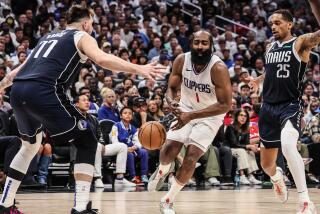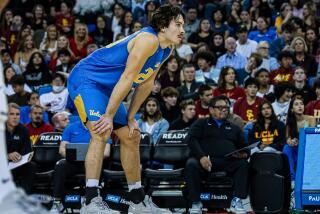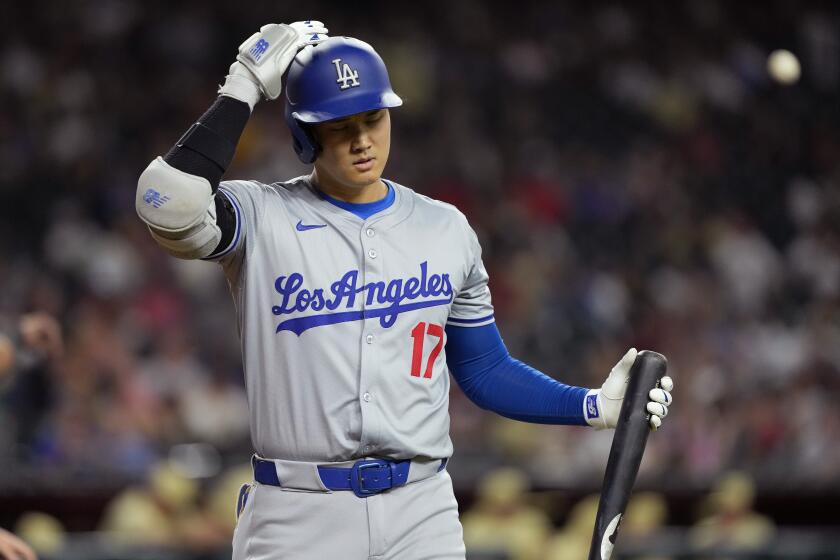Big Ten Leaders Face NCAA Jinx
The Big Ten may have reached the top of the college basketball mountain in 1980.
Flushed with the success of Michigan State and Magic Johnson winning the NCAA title the year before, the league sent two teams, Iowa and Purdue, to the Final Four. It didn’t really matter that neither one reached the championship game. The Big Ten was college basketball’s hottest topic.
Since that time, Big Ten basketball can be viewed from two perspectives -- one that includes Indiana and Coach Bob Knight and one that doesn’t.
Including Knight’s Hoosiers, the Big Ten can claim a pair of national championships and an impressive 39-31 ledger in NCAA play in the ‘80s. Without Indiana, the Big Ten mark is 24-27. Indiana has the best record in NCAA play (15-4) during that time, including last year’s 6-0 route to the title.
The rest of the cast has been filled with in-season promise and post-season regret.
This year, Purdue (No. 2) and Michigan (No. 10) will likely be the Big Ten’s front-runners for NCAA play. And those two teams have been the league’s biggest disappointments in NCAA tournaments in this decade.
“I don’t know how we’re going to do but at least we’re hopeful we don’t have to beat someone on their home floor like we’ve faced in the past,” said Purdue Coach Gene Keady.
In 1984, the Boilermakers had to play at Memphis State in their first game and lost 66-48. Two years later, Purdue came up against LSU on the Tigers’ home floor. It took two overtimes but the Boilermakers fell short again, 94-87.
Last year, Purdue at least escaped the home floor problem but lost convincingly, 85-66, to Florida in its second game.
Michigan was ranked No. 2 in the country in 1985. The Wolverines squeezed by unheralded Farleigh Dickinson before losing to eventual NCAA champion Villanova, 59-55.
“It’s funny in a way that people only seem to remember what you don’t get done in the NCAA,” says Michigan Coach Bill Frieder. “We’ve had some great seasons, won more Big Ten championships in recent years than anyone, but because we haven’t gone all the way in the NCAA people think we aren’t as successful.”
After Indiana, only Iowa (current No. 14) has been able to post a winning NCAA mark in the 1980s. The Hawkeyes are 10-8 but four of those wins came back in 1980. Iowa got to within three points of the Final Four last year, losing to UNLV 84-81 after blowing a big second half lead.
Illinois has also been a victim of the great regular season, bad post-season dilemma. The Illini have been in the NCAA every year since 1983 but have a 5-5 record to show for their tournament efforts. Included were upsets to unheralded Austin Peay 68-67 last year, and a 52-49 defeat against Utah in 1983.
“That’s all people talked about during the off-season. How could we lose to Austin Peay?” recalls Illini Coach Lou Henson. “Never mind that we won more than 20 games or accomplished all we accomplished. We lost to Austin Peay.”
Ohio State is 4-5 in NCAA tournaments of the ‘80s, Michigan State 2-2 and Minesota 1-1.
Theories abound as to why the Big Ten hasn’t fared so well (and why Indiana has bucked the trend.)
Some argue the lack of a post-season Big Ten tournament puts the conference at a disadvantage. Critics argue other conferences prepare for NCAA tournament pressure during their league tourneys.
“But I don’t buy that,” Purdue’s Keady says. “The other side of that argument is the teams that get into the tourney after playing in a league tourney are worn out.”
Others claim the grueling 18-game round-robin Big Ten schedule wears down tournament caliber teams. That is a major factor in the stalled plans for a league tournament. Coaches insist before the Big Ten goes to a revenue-rich league tourney the regular season be cut to 14 or 15 games.
Officiating is also cited. The Big Ten is known for its rough physical style; officials usually allow rough play under the boards and don’t call as many fouls. When Big Ten teams get into the NCAA, games are called much more closely, forcing league clubs to switch styles or get into serious foul trouble.
The exception to all the theories is Knight’s success. Indiana has won 15 of its last 19 NCAA tourney games and two national championships.
The rationale usually given is that Knight understands how to get his team peaked at just the right time. Rather than being concerned about high national ranking or Big Ten titles, he uses the regular season as a testing ground for the NCAA tournament. Once the tourney has begun, he has fresher players who are peaking at the right time.
The Big Ten is likely to send six teams to the NCAA tourney for the fourth straight year, Indiana among them.
League teams, particularly Purdue and Michigan, can shoot down some of the league’s critics’ theories with good showings. But if the Big Ten should fail again and Indiana be the school to advance the farthest, some of those questions are likely to be raised again.
More to Read
Get our high school sports newsletter
Prep Rally is devoted to the SoCal high school sports experience, bringing you scores, stories and a behind-the-scenes look at what makes prep sports so popular.
You may occasionally receive promotional content from the Los Angeles Times.






